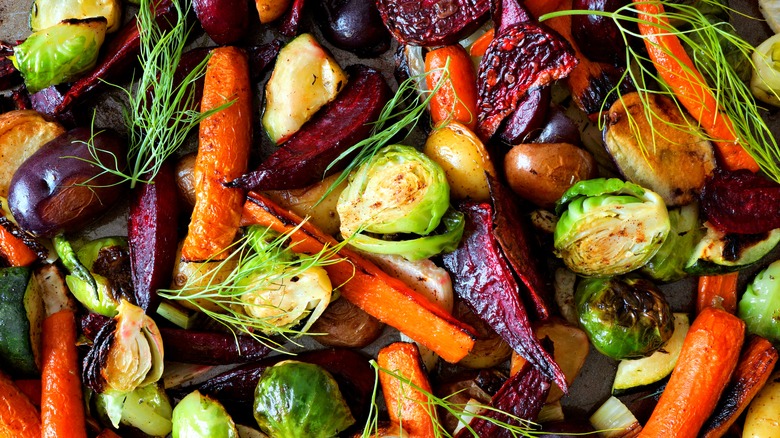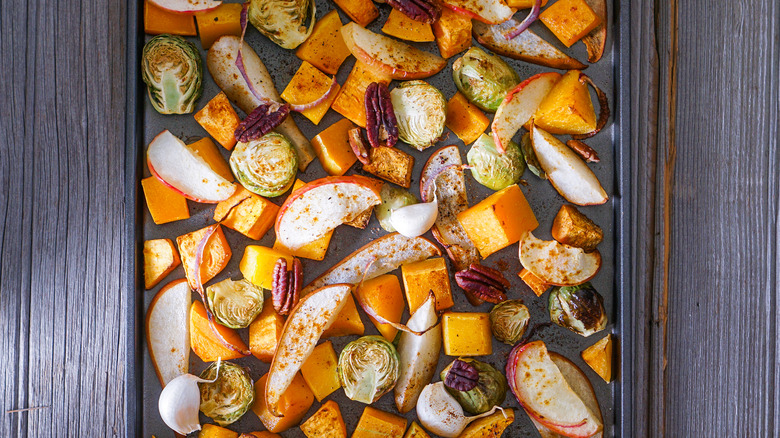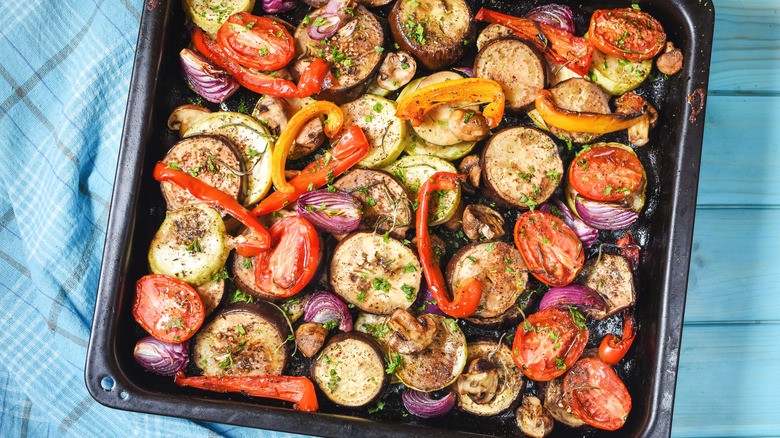You're Tossing Oil On Your Roasted Vegetables At The Wrong Time
Roasted vegetables are basically the king of meal sides, considering their versatility and color that can add a bit of life to your meals. Need something to complement that protein perfectly? Roast up some Brussels sprouts and carrots. Want something light and nutritious but still supremely tasty? Cook your broccoli or cauliflower to an ideal texture. Out of ideas and have some random vegetables sitting in the fridge? Get that oven going.
Roasted vegetables go with anything and everything, they're generally very healthy depending on your toppings, and they couldn't be easier to prepare. All you need to do is cut your favorite veggies to your preferred thickness and toss in olive oil and seasonings. Throw it all in a hot oven until the optimal roast level is reached. But what if we've been doing it wrong?
There may be a better way; all it requires is a simple change of order. There is such a thing as a dry roast, which might just be a game-changer for your roasted veggies.
First comes roasting, then comes olive oil
Next time you're ready to throw that sheet pan of vegetables into the oven for a good roast, resist the urge to oil them up. Chef Nick Balla of COAST Big Sur Cafe is a big believer in dry roasting vegetables first and then adding your fatty oil or flavorful sauce once they're cooked. "Dry roasting makes for a more natural pairing because you retain a lot of freshness and brightness, and they absorb the fat anyway," he tells Food & Wine. He says dry roasting ultimately makes for tastier vegetables with more complex aromas and flavors.
The reason this is true is that most vegetables naturally contain a lot of water, so when you roast them on their own rather than douse them with more liquid, that water is able to dry up. As a result, the vegetables become more absorbent — putting them in an even better position to soak up the delicious flavors and fats of whatever you coat them with. And because the process of roasting caramelizes the sugars in the veggies, it produces deeper flavor, texture, and aromatic compounds, giving the vegetables a chance to truly shine before any other elements get in their way.
Roasting tips for perfect veggies every time
Your possibilities are pretty much endless when it comes to roasting vegetables; aside from soft leafy greens, just about anything will roast up nicely in the oven. But not all vegetables are created equal, so depending on what you choose, there are different methods to achieving the optimal roasted veggie outcome.
Let's go with an oven temperature of 425 degrees Fahrenheit, which will generally work for most veggies. If you have something hearty like root vegetables or winter squash, those will take the longest to cook through and crisp up. For things like roasted potatoes, beets, carrots, or butternut squash, a good rule of thumb is around 45 minutes. For cruciferous veggies like cauliflower and broccoli, think 20 to 25 minutes. And thinner veggies like asparagus or those with a higher water content like zucchini require a shorter cooking time: only 10 to 20 minutes.
Some general tips to keep in mind: The smaller you chop the vegetable, the less time you'll need in the oven. Try not to overcrowd your pan; veggies need space so they don't end up steaming on top of each other. And lastly, be sure to flip or rotate your veggies every so often to get an even roast and crispness.


